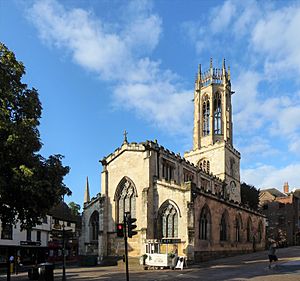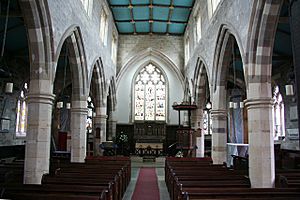All Saints' Church, Pavement, York facts for kids
Quick facts for kids All Saints’ Church, Pavement, York |
|
|---|---|

All Saints’ Church, Pavement, York
|
|
| 53°57′31.23″N 1°4′49.31″W / 53.9586750°N 1.0803639°W | |
| Location | York |
| Country | England |
| Denomination | Church of England |
| Churchmanship | Low church/Prayer Book |
| Website | allsaintspavement.co.uk |
| History | |
| Dedication | All Saints |
| Architecture | |
| Heritage designation | Grade I listed |
| Administration | |
| Parish | All Saints, Pavement with St Crux and St Michael Spurriergate, York |
| Deanery | York |
| Archdeaconry | York |
| Diocese | Diocese of York |
| Province | Province of York |
All Saints’ Church, Pavement, York is a very old church in the city of York, England. It is part of the Church of England. This church is special because it is a Grade I listed building. This means it is considered very important and protected for its history and architecture. Services here follow the Book of Common Prayer.
Contents
A Look Back in Time: The Church's History
All Saints’ Church was first built a long, long time ago, in the 1300s. Over the years, parts of the church have been changed and rebuilt. For example, in 1780, the east end of the church was rebuilt. Later, in 1834, the north wall and the west end were also rebuilt.
Changes and Restorations Over the Years
The church's special lantern tower was rebuilt in 1837. A vestry, which is a room used by the clergy, was added between 1850 and 1855. The church had a big restoration project in 1887. During this time, the stone was cleaned, and the tall, pointed decorations called pinnacles were fixed. A beautiful stained glass window by Charles Eamer Kempe was also put in the central east window. The church was made even larger in 1912.
Special Roles of the Church
All Saints’ Church is very important to the city of York. It serves as the official church for the city's guilds and civic events. Guilds were like old-fashioned clubs for people who did the same job. It is also the regimental church for the Royal Dragoon Guards. This means it has a special connection to this army regiment. In 1954, All Saints’ Church joined with the parish of St Saviour's Church, York. This happened when St Saviour's Church was no longer used for regular services.
Remembering Important People: Memorials
Inside the church, there are memorials to many people from the past. These are like special plaques or stones that remember important individuals. Some of these memorials were moved here from other churches that are no longer in use.
- Sergeant Major John Polety (died 1829)
- Charles Polety (died 1838)
- Tate Wilkinson (died 1803)
- Jane Wilkinson (died 1826)
- Sir Robert Crathorn (died 1482)
- Robert Askwith (died 1579)
- Roger de Moreton (died 1382)
- Isabella de Moreton (died 1412)
- Ursula Wyvill (died 1790)
- Robert Bishopricke Surgeon (died 1814)
- Henry Richards (died 1783)
The Church Organ
The church has an organ, which is a large musical instrument. You can find more details about this organ on the National Pipe Organ Register.
Understanding the Tower: What is a Lantern Tower?
The tower at All Saints’ Church has a famous lantern. However, it's important to know that this isn't a "lantern tower" in the usual architectural sense. A true lantern tower has a special upper section above the main church ceiling. This section is open to the inside of the church below the tower. It helps bring more light into the building. The tower at All Saints’ Church is different from this specific type.
Images for kids



